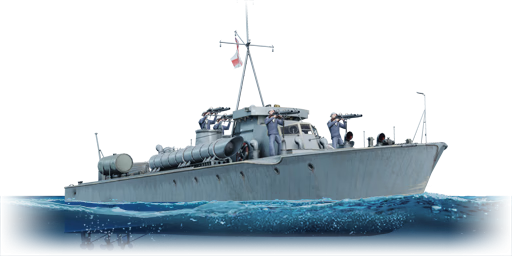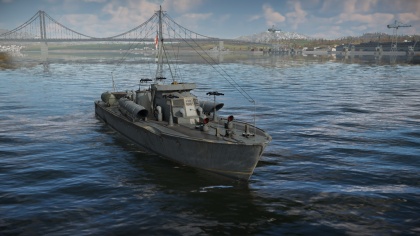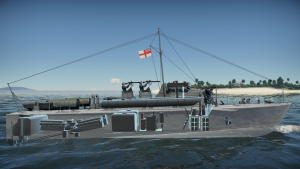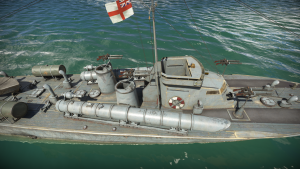Difference between revisions of "MTB Vosper"
m (→Torpedo armament: wording) |
(Expanded History, added two new sources; removed extraneous external links) |
||
| Line 218: | Line 218: | ||
<!--''Describe the history of the creation and combat usage of the ship in more detail than in the introduction. If the historical reference turns out to be too big, take it to a separate article, taking a link to an article about the vehicle and adding a block "/ History" (example: <nowiki>https://wiki.warthunder.com/(Vehicle-name)/History</nowiki>) and add a link to it here using the <code>main</code> template. Be sure to reference text and sources by using <code><nowiki><ref></nowiki></code>, as well as adding them at the end of the article.''--> | <!--''Describe the history of the creation and combat usage of the ship in more detail than in the introduction. If the historical reference turns out to be too big, take it to a separate article, taking a link to an article about the vehicle and adding a block "/ History" (example: <nowiki>https://wiki.warthunder.com/(Vehicle-name)/History</nowiki>) and add a link to it here using the <code>main</code> template. Be sure to reference text and sources by using <code><nowiki><ref></nowiki></code>, as well as adding them at the end of the article.''--> | ||
| − | During the 1930s, the Admiralty tried to reestablish the coastal boat flotillas it once | + | During the 1930s, the Admiralty tried to reestablish the coastal boat flotillas it once commanded during the First World War. British boatbuilding company Vosper & Company competed for the contract but lost both times in 1935 and 1936, the lucrative contract to build the first coastal boats since WWI going instead to their rival, British Power Boat Company. In response to this, Vosper developed a faster and more seaworthy design than that of their rivals'. In the following months, Vospers proposed their design to the Admiralty multiple times, but ultimately, they could not secure a contract to build a prototype. Around this time, though, the Admiralty officials had unofficially suggested that future contracts would only be awarded for vessels that could surpass 40 knots in speed and that were armed with two 21-inch torpedoes as well as an assortment of light anti-aircraft guns. Additionally, it was known from previous specifications that the Admiralty wanted a vessel capable of operating in open waters in at least Force 5 winds and that was fast enough to cross the English Channel during the night. With these unofficial specifications, Vospers preemptively began development on a new vessel as a private venture of the company's own expense. |
| − | + | Immediately, it was decided that the private venture vessel had to be larger than the existing 60 ft British Power Boat MTB in order to meet the specifications. Additionally, engines more powerful than the Napier Sea Lion engines used in the BPB design were required. With none available domestically, Vospers looked to the Asso 1000 engine by Italian manufacturer Isotta-Fraschini. Though in limited supply, the Asso 1000 was specifically designed for marine craft and provided the necessary power: 1150 bhp at 1500 rpm maximum and 950 bhp at 1660 rpm continuous. In late 1936, Vospers completed their design. It called for three Asso 1000 engines and two in-house 75 bhp auxiliary engines, the latter of which could be coupled to the outer shafts to give a total maximum power of 3600 bhp. The hull-form was a hard chine planing design and was 69½ ft in length with a displacement of about 33 tons. The prototype was laid down before the end of the year and completed in May 1937. | |
| − | + | Upon completion, the prototype underwent internal trials where she achieved a top speed of 47.8 knots unloaded and 43.7 knots loaded. Satisfied with these results, Vospers presented the prototype to the Admiralty for official trials against the 60 ft British Power Boat MTB. The prototype faired favorably, and after the trials and much deliberation, the Admiralty decided to purchase the vessel from Vospers. She was commissioned in May 1938 as MTB 102 and sent to HMS Vernon for further evaluation. Up to this point, MTB 102 had not actually been fitted with torpedoes, so during her time at HMS Vernon, many torpedo configurations were tested. These included tried-and-true yet outdated stern projection systems as seen on the 60 ft British Power Boat MTB and earlier WWI designs as well as a unique arrangement of a single launcher in the stem of the hull with a reload carried internally. These all had their own issues, and none were found to be satisfactory. Ultimately, it was decided that MTB 102 should have two torpedo tubes mounted on either side of the bridge, pointed forwards with the nose angled outwards, an uncommon configuration for the time. Around this time, the gun armament had also not yet been decided, so various configurations were also experimented with, including combinations of 0.303 in and 0.50 in machineguns and a 20 mm autocannon. | |
| − | + | Impressed with MTB 102, the Admiralty placed an order for four more vessels on 15th August 1938, Vospers' first-ever Admiralty contract. These vessels, and any ordered after, all shared the same overall design as MTB 102, although with several minor changes such as the hull being lengthened to 70 ft 3¼ in. After 1940, with the entrance of Italy into the war, Isotta-Fraschini engines could no longer be obtained, and subsequent boats had to be fitted with much weaker American Hall Scott engines — only 1800 bhp total — as a stopgap measure until they could be upgraded with more powerful Packard engines, though this wasn't until 1941 as supply was limited. Of the 32 planned 70 ft Vosper MTBs, 28 were completed and are as follows: | |
| − | * MTBs | + | * MTBs 20-23: Ordered 15th August 1938, all were completed by December 1939. MTBs 20, 21, and 23 were sold to the Romanian Navy. MTB 22 served with the 4th MTB Flotilla and survived to the end of the war and was sold in 1945. |
| − | * MTBs | + | * MTBs 29-30: Ordered on 8th September 1938 (including a Thornycroft design, MTB 28) as replacements for the three boats sold to Romania, all were completed by July 1940. Both MTB 29 and 30 served with the 4th MTB Flotilla. MTB 29 was lost in a collision with a German E-boat on 6th October 1942, and MTB 30 struck a mine and was lost on 18th December 1942. |
| − | * MTBs | + | * MTBs 31-40: Ordered on 27th September 1939, six were completed by May 1941. MTBs 33, 37, 39, and 40 were bombed by German aircraft while under construction in 1940-41. The completed boats survived to the end of the war and were sold in 1945-46. |
| − | * MTBs | + | * MTBs 57-66: Ordered on 26th February 1940, all were completed by April 1942. MTB 61 was stranded during an attack on 9th May 1943, and MTBs 63 and 64 were lost after collisions with friendly MTBs on 2nd April 1943. The remaining boats were sold in 1944. |
| − | * MTBs | + | * MTBs 69-70: Ordered in April 1940, both were completed by June 1940 and received only two engines. Both were stationed at HMS Beehive, Felixstowe and survived to the end of the war and were sold in 1945-46. |
| − | + | * MTBs 218-221: Ordered on 7th December 1940, all were completed by September 1941. MTB 218 struck a mine and was lost on 18th August 1942, and MTB 220 was sunk by German E-boats on 13th May 1942. MTBs 219 and 221 survived to the end of the war. MTB 221 was sold in 1945, and MTB 219 was transferred to the Sea Cadet Corps at Staines in 1945 and was converted to a houseboat in 1948. | |
| + | |||
| + | The 70 ft Vosper MTB design continued to receive many improvements and modifications order-to-order and would lead to the development of the 72 ft Vosper MTB and 73 ft Vosper MTB. | ||
== Media == | == Media == | ||
| Line 264: | Line 266: | ||
* ''other literature.''--> | * ''other literature.''--> | ||
| + | * [http://cfv.org.uk/research/boat/database Coastal Forces Veterans - Boat Database] | ||
* [http://www.ww2ships.com/britain/gb-sc-002-b.shtml ww2ships.com - 70' Vosper Motor Torpedo Boat] | * [http://www.ww2ships.com/britain/gb-sc-002-b.shtml ww2ships.com - 70' Vosper Motor Torpedo Boat] | ||
* [https://www.unithistories.com/units_british/RN_MTBs.html#MTB_Boats unithistories.com - Royal Navy Coastal Forces 1940-1945] | * [https://www.unithistories.com/units_british/RN_MTBs.html#MTB_Boats unithistories.com - Royal Navy Coastal Forces 1940-1945] | ||
* [http://www.naval-history.net/WW2BritishLosses3Coastal.htm naval-history.net - British vessels lost at sea in World War 2 - MGB, MTB, SGB, ML, etc] - originally published in British Vessels Lost at Sea, 1935-45, His Majesty's Stationary Office, 1947 | * [http://www.naval-history.net/WW2BritishLosses3Coastal.htm naval-history.net - British vessels lost at sea in World War 2 - MGB, MTB, SGB, ML, etc] - originally published in British Vessels Lost at Sea, 1935-45, His Majesty's Stationary Office, 1947 | ||
| − | * | + | |
| − | + | ===Bibliography=== | |
| + | |||
| + | * Lambert, J., & Ross, A. (1993). ''Allied Coastal Forces of World War II Volume II: Vosper MTBs & U.S. Elcos'' (pp. 21-32). London, England: Conway Maritime Press. ISBN 0-85177-602-7. | ||
{{Britain boats}} | {{Britain boats}} | ||
Revision as of 03:55, 2 October 2020
Contents
Description
The MTB Vosper 1 series is a rank I British motor torpedo boat
with a battle rating of 1.0 (AB/RB/SB). It was introduced in Update 1.83 "Masters of the Sea" as part of the British fleet closed beta test.
General info
Survivability and armour
MTB Vosper has the following armour layout:
- Hull: 24 mm, wood
- Superstructure: 15 mm, wood
Any gun in the game will easily be able to penetrate the hull and superstructure at any practical range.
MTB Vosper can be hull-broken by any gun that is greater than 4 inches (102 mm) in diameter. Hull-break is triggered when any such gun hits and destroys any hull compartment — or in some cases, the bridge — with a high-explosive round, upon which the rest of the boat will be destroyed. At MTB Vosper' battle rating, there is only one gun capable of hull-breaking her:
- the 8cwt QF Mk I, found on Dark Adventurer.
MTB Vosper' hull is split into three compartments. The first compartment starts at the bow and ends in front of the bridge; the second ends behind the aft gun mounts, just after the fuel tanks; and the third ends at the stern.
MTB Vosper has one ammunition storage that holds ammunition for all gun turrets. It is located directly below the bridge, just above the waterline. Destroying it will instantly destroy the boat.
With a crew complement of 10, MTB Vosper' overall survivability is below-average.
Mobility
| Mobility Characteristics | |||||
|---|---|---|---|---|---|
| Game Mode | Upgrade Status | Maximum Speed (km/h) | Turn Time (s) | Turn Radius (m) | |
| Forward | Reverse | ||||
| AB | Stock | 76 | 27 | ~19.42 | ~37.78 |
| Upgraded | 104 | 36 | ~12.61 | ~23.97 | |
| RB/SB | Stock | 64 | 22 | ~21.92 | ~43.61 |
| Upgraded | 74 | 26 | ~17.83 | ~34.68 | |
MTB Vosper has a displacement of 38 tons.
When moving at high speeds, either forwards of backwards, MTB Vosper will drift slightly to starboard without any player input.
Armament
Primary armament
The primary armament consists of eight 7.72 mm Lewis 1916 machineguns in four twin mounts, two side-by-side in front of the bridge and two staggered behind the bridge. There are 1,940 rounds of ammunition available for each mount, 970 rounds per gun, for a total of 7,760 rounds. Stock, the mounts can traverse horizontally and vertically at a rate of 64°/s; with the "Primary Armament Targeting" modification installed, this is increased to 75°/s. Each gun has a magazine capacity of 97 rounds and a rate of fire of 550 rounds/min. With a stock crew, the guns can be reloaded in 10.4 seconds; with an aced crew, they can be reloaded in 8 seconds.
| Turrets are named sequentially, clockwise, starting at the bow |
| Primary Armament Guidance | |||||||
|---|---|---|---|---|---|---|---|
| No.1 Turret (fore-starboard) | No.2 Turret (aft-starboard) | No.3 Turret (aft-port) | No.4 Turret (fore-port) | ||||
| Horizontal | Vertical | Horizontal | Vertical | Horizontal | Vertical | Horizontal | Vertical |
| ±180° | -7°/+70° | ±180° | -10°/+70° | ±180° | -10°/+70° | ±180° | -7°/+70° |
There are three ammunition choices available:
- Universal: AP · T · AP · T
- 7.7 mm AP belt: AP · AP · AP · T
- 7.7 mm API belt: IT · IT · IT · AP
| Penetration Statistics | ||||||
|---|---|---|---|---|---|---|
| Ammunition | Penetration @ 0° Angle of Attack (mm) | |||||
| 10 m | 100 m | 500 m | 1,000 m | 1,500 m | 2,000 m | |
| Universal | 10 | 9 | 8 | 7 | 6 | 5 |
| 7.7 mm AP belt | 10 | 9 | 8 | 7 | 6 | 5 |
| 7.7 mm API belt | 10 | 9 | 8 | 7 | 6 | 5 |
Torpedo armament
MTB Vosper can carry two 533 mm Mk.VIII torpedoes. The torpedo tubes are located on either side of the bridge, pointed forwards with the nose angled outwards.
| Torpedo Characteristics | ||||||||
|---|---|---|---|---|---|---|---|---|
| Torpedo Mode | Mass (kg) | Maximum speed in water (km/h) | Travel distance (km) | Depth stroke (m) | Arming distance (m) | Explosive type | Explosive mass (kg) | TNT equivalent (kg) |
| No | 1,566 | 50 | 4.57 | 1 | 50 | TNT | 327 | 327 |
| Yes | 76 | 6.40 | ||||||
The Torpedo Mode modification is available as a rank IV modification. Installing it will give the following changes:
| Torpedo Mode Specification Changes | |
|---|---|
| Max Distance (m) | Max Speed (m/s) |
| +1830 | -1 |
MTB Vosper has two possible loadouts:
- 2x Mk.VIII torpedo
- Without load
Usage in battles
In terms of armament, Vosper 1 series is very similar to the vehicle that comes directly before it in the tech tree, MTB-1(1), the difference being in the placement of the guns. While MTB-1 1 series has the eight guns split into two quadruple mounts, Vosper 1 series has them in four twin mounts. With this arrangement, Vosper 1 series can only bring six of her eight guns on target at once, since the mounts block each other at most angles. Althought there is a small ~7.5° arc about 60° to port (between the 9 and 10 o'clock positions) where all eight guns can be used at once, it's difficult to keep targets in such a small range, so this shouldn't be relied on. Still, with only six guns, you should be able to destroy most targets without needing to reload. On the other hand, having the guns arranged like this does have its own benefits, the most obvious being the much quicker reload times, nearly half of that on MTB-1 1 series depending on the crew skills. Having twin mounts instead of quad mounts also makes each individual mount smaller; losing a turret to random fire is less likely and, should it happen, is less detrimental.
Differences aside, Vosper 1 series has virtually the same playstyle as MTB-1 1 series. The guns have a low per-hit damage output and a low maximum range, so stick to close-range engagements to nullify those disadvantages. Vosper 1 series is actually quite a bit faster than MTB-1 1 series; use it to your advantage to get to ambush positions o the map that MTB-1 1 series wouldn't be able to in time. Like MTB-1 1 series, even with the quicker reload, it's still a good idea to fire off any remaining ammunition after engagements.
- Ammunition Choices
The best ammunition choice is the 7.7 mm AP belt since it has the highest ratio of AP to T rounds. While the 7.7 mm API belt may look tempting because of the incendiary tracer rounds and lack of tracer rounds, the IT rounds can actually be stopped by some wooden hulls and almost all metal hulls. Additionally, their damage output is closer to that of the standard tracer round than the AP round, and they rarely start fires, if ever. While the IT rounds are technically the best against aircraft, with such a long reload time to switch to the API belt and with barely any noticable difference, there's really no point in using the API belt for that either. Take only the AP belt.
- Torpedoes
The Mk.VIII torpedoes are a decent torpedo with above-average top speeds and warhead size. Its maximum range is more of less average. The Torpedo Mode modification should never be installed. The higher maximum speed is much more valuable against the fast boats of this tier, and the maps are small enough that the decreased maximum range doesn't really matter.
Be aware though that, if the torpedo is unused, it can be shot at, and, if it's destroyed, there is a chance the entire boat can be destroyed along with it. For this reason, it's best to either use them early on or to not take them into battle at all.
Modules
| Tier | Seakeeping | Unsinkability | Firepower | |||
|---|---|---|---|---|---|---|
| I | Dry-Docking | Tool Set | 7.7 mm AP belt | |||
| II | Rudder Replacement | Fire Protection System | Smokescreen | 7.7 mm API belt | ||
| III | Propeller Replacement | Primary Armament Targeting | ||||
| IV | Engine Maintenance | New Pumps | Artillery Support | Torpedo Mode | ||
Pros and cons
Pros:
- Good manoeuvrability
- Good torpedoes: above-average maximum speed and explosive charge
Cons:
- Main armament consists only of low-calibre machineguns: low damage output per gun
- Not all gun mounts can be on target at once, one or more of the turrets will be blocked at most angles
- Below-average survivability
History
During the 1930s, the Admiralty tried to reestablish the coastal boat flotillas it once commanded during the First World War. British boatbuilding company Vosper & Company competed for the contract but lost both times in 1935 and 1936, the lucrative contract to build the first coastal boats since WWI going instead to their rival, British Power Boat Company. In response to this, Vosper developed a faster and more seaworthy design than that of their rivals'. In the following months, Vospers proposed their design to the Admiralty multiple times, but ultimately, they could not secure a contract to build a prototype. Around this time, though, the Admiralty officials had unofficially suggested that future contracts would only be awarded for vessels that could surpass 40 knots in speed and that were armed with two 21-inch torpedoes as well as an assortment of light anti-aircraft guns. Additionally, it was known from previous specifications that the Admiralty wanted a vessel capable of operating in open waters in at least Force 5 winds and that was fast enough to cross the English Channel during the night. With these unofficial specifications, Vospers preemptively began development on a new vessel as a private venture of the company's own expense.
Immediately, it was decided that the private venture vessel had to be larger than the existing 60 ft British Power Boat MTB in order to meet the specifications. Additionally, engines more powerful than the Napier Sea Lion engines used in the BPB design were required. With none available domestically, Vospers looked to the Asso 1000 engine by Italian manufacturer Isotta-Fraschini. Though in limited supply, the Asso 1000 was specifically designed for marine craft and provided the necessary power: 1150 bhp at 1500 rpm maximum and 950 bhp at 1660 rpm continuous. In late 1936, Vospers completed their design. It called for three Asso 1000 engines and two in-house 75 bhp auxiliary engines, the latter of which could be coupled to the outer shafts to give a total maximum power of 3600 bhp. The hull-form was a hard chine planing design and was 69½ ft in length with a displacement of about 33 tons. The prototype was laid down before the end of the year and completed in May 1937.
Upon completion, the prototype underwent internal trials where she achieved a top speed of 47.8 knots unloaded and 43.7 knots loaded. Satisfied with these results, Vospers presented the prototype to the Admiralty for official trials against the 60 ft British Power Boat MTB. The prototype faired favorably, and after the trials and much deliberation, the Admiralty decided to purchase the vessel from Vospers. She was commissioned in May 1938 as MTB 102 and sent to HMS Vernon for further evaluation. Up to this point, MTB 102 had not actually been fitted with torpedoes, so during her time at HMS Vernon, many torpedo configurations were tested. These included tried-and-true yet outdated stern projection systems as seen on the 60 ft British Power Boat MTB and earlier WWI designs as well as a unique arrangement of a single launcher in the stem of the hull with a reload carried internally. These all had their own issues, and none were found to be satisfactory. Ultimately, it was decided that MTB 102 should have two torpedo tubes mounted on either side of the bridge, pointed forwards with the nose angled outwards, an uncommon configuration for the time. Around this time, the gun armament had also not yet been decided, so various configurations were also experimented with, including combinations of 0.303 in and 0.50 in machineguns and a 20 mm autocannon.
Impressed with MTB 102, the Admiralty placed an order for four more vessels on 15th August 1938, Vospers' first-ever Admiralty contract. These vessels, and any ordered after, all shared the same overall design as MTB 102, although with several minor changes such as the hull being lengthened to 70 ft 3¼ in. After 1940, with the entrance of Italy into the war, Isotta-Fraschini engines could no longer be obtained, and subsequent boats had to be fitted with much weaker American Hall Scott engines — only 1800 bhp total — as a stopgap measure until they could be upgraded with more powerful Packard engines, though this wasn't until 1941 as supply was limited. Of the 32 planned 70 ft Vosper MTBs, 28 were completed and are as follows:
- MTBs 20-23: Ordered 15th August 1938, all were completed by December 1939. MTBs 20, 21, and 23 were sold to the Romanian Navy. MTB 22 served with the 4th MTB Flotilla and survived to the end of the war and was sold in 1945.
- MTBs 29-30: Ordered on 8th September 1938 (including a Thornycroft design, MTB 28) as replacements for the three boats sold to Romania, all were completed by July 1940. Both MTB 29 and 30 served with the 4th MTB Flotilla. MTB 29 was lost in a collision with a German E-boat on 6th October 1942, and MTB 30 struck a mine and was lost on 18th December 1942.
- MTBs 31-40: Ordered on 27th September 1939, six were completed by May 1941. MTBs 33, 37, 39, and 40 were bombed by German aircraft while under construction in 1940-41. The completed boats survived to the end of the war and were sold in 1945-46.
- MTBs 57-66: Ordered on 26th February 1940, all were completed by April 1942. MTB 61 was stranded during an attack on 9th May 1943, and MTBs 63 and 64 were lost after collisions with friendly MTBs on 2nd April 1943. The remaining boats were sold in 1944.
- MTBs 69-70: Ordered in April 1940, both were completed by June 1940 and received only two engines. Both were stationed at HMS Beehive, Felixstowe and survived to the end of the war and were sold in 1945-46.
- MTBs 218-221: Ordered on 7th December 1940, all were completed by September 1941. MTB 218 struck a mine and was lost on 18th August 1942, and MTB 220 was sunk by German E-boats on 13th May 1942. MTBs 219 and 221 survived to the end of the war. MTB 221 was sold in 1945, and MTB 219 was transferred to the Sea Cadet Corps at Staines in 1945 and was converted to a houseboat in 1948.
The 70 ft Vosper MTB design continued to receive many improvements and modifications order-to-order and would lead to the development of the 72 ft Vosper MTB and 73 ft Vosper MTB.
Media
See also
External links
- Coastal Forces Veterans - Boat Database
- ww2ships.com - 70' Vosper Motor Torpedo Boat
- unithistories.com - Royal Navy Coastal Forces 1940-1945
- naval-history.net - British vessels lost at sea in World War 2 - MGB, MTB, SGB, ML, etc - originally published in British Vessels Lost at Sea, 1935-45, His Majesty's Stationary Office, 1947
Bibliography
- Lambert, J., & Ross, A. (1993). Allied Coastal Forces of World War II Volume II: Vosper MTBs & U.S. Elcos (pp. 21-32). London, England: Conway Maritime Press. ISBN 0-85177-602-7.
| Britain boats | |
|---|---|
| Motor torpedo boats | Brave Borderer · Dark Aggressor · Dark Aggressor TD · Fairmile D (617) · Fairmile D (697) · Fairmile D (5001) · HMS Gay Archer |
| MTB-1(1) · MTB-1(2) · MTB Vosper · MTB Vosper(2) · MTB-422 | |
| Motor gun boats | Dark Adventurer · Fairmile A (ML100) · Fairmile B (ML345) · Fairmile C (312) · Fairmile C (332) · Fairmile D (601) · Fairmile H LCS(L)(2) |
| HMAS Arrow · HMAS Fremantle · MGB-61 · MGB-75 · ML 1383 · SGB Grey Fox · SGB Grey Goose | |
| Gunboats | HMS Spey |








